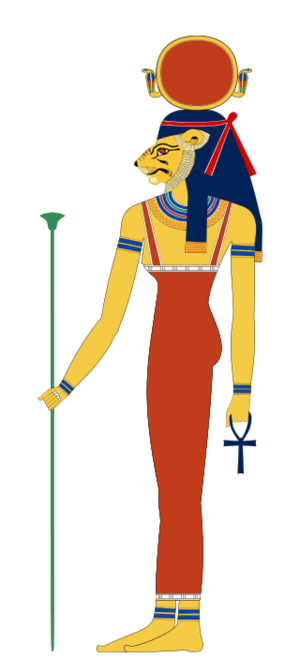テフヌト
テフヌト(Tefnut)は、エジプト神話における湿気の女神。ヘリオポリス九柱神に数えられる。テフヌト、テフヌウト、テフェネト、テフヌートなどとも表記され、ギリシア語ではトフェニスと呼ばれる。
テフヌト(古代エジプト語: tfn.t; コプト語:ⲧϥⲏⲛⲉ、tfēne)[1][2]は、古代エジプトの宗教における水分、湿った空気、露、雨の神である[3]。大気の神シューの妹及び妃であり、ゲブとヌトの母である。
語源
テフヌトの名前の語源は定かではないが、創世神話でアトゥムが彼女を吐き出すように、吐き出す音のオノマトペである可能性もある。さらに、テフヌトの名前は、後期のテキストでは、口が吐くと書かれていた[4]。
テフヌトの兄を含む多くのエジプトの神々と同様に、テフヌトは単一の表意文字や記号を持っていない。彼女の名前を象形文字で表すと、4つの単一音素記号t-f-n-tで構成される。nの音素は水面の波を表現しているが、水(mw)という言葉や水に関連するものの表意文字や決定文字として使われることはなかった[5]。
神話的起源
テフヌトは、太陽神ラー・アトゥムの娘である。双子の弟シューと結婚し、天のヌトと大地のゲブの母である。テフヌトの孫には、オシリス、イシス、セト、ネフティス、そしてあるバージョンでは長男のホルスがいます。また、若かりし頃のホルスの曾祖母でもある。父、兄、子供、孫、ひ孫と並んで、ヘリオポリスのエネアドのメンバーである。
テフヌトとシューの双子の創造神話には、いくつかの異説がある。どの説もテフヌトは単為生殖の産物で、何らかの体液が関与している。
ヘリオポリスの創造神話では、アトゥムがくしゃみをして、テフヌットとシュウを生み出した[6]。ピラミッドテキスト527には、「アトゥムはヘリオポリスでくしゃみをしながら進んだという点で創造的であった。そして、兄と妹が生まれた。それがシューとテフヌトである[7]。」とある。
この神話のいくつかのバージョンでは、アトゥムは唾液を吐き出し、それが子孫繁栄の行為となる。このバージョンでは、テフヌートの名前の最初の音節を形成するテフ音は、「唾を吐く」または「痰を吐く」という意味の単語を構成する、言葉遊びを含んでいる[7]。
『死者の書』には、アトゥムがシューを鼻からくしゃみで吐き出したり、テフヌトを唾液のように吐き出したりする描写がある。ブレムナー・リンド・パピルスとメンフィス神話は、アトゥムが唾液をくしゃみして双子を形成したと記述している[8]。
イコノグラフィー
テフヌトは獅子系の神で、ヘリオポリスの大円柱の一部として描かれたときは、獅子の頭を持つ人間の姿をしている。
Tefnut is a leonine deity, and appears as human with a lioness head when depicted as part of the Great Ennead of Heliopolis. The other frequent depiction is as a lioness, but Tefnut can also be depicted as fully human. In her fully or semi anthropomorphic form, she is depicted wearing a wig, topped either with a uraeus serpent, or a uraeus and solar disk, and she is sometimes depicted as a lion headed serpent. Her face is sometimes used in a double headed form with that of her brother Shu on collar counterpoises.[9]
During the 18th and 19th Dynasties, particularly during the Amarna Period, Tefnut was depicted in human form wearing a low flat headdress, topped with sprouting plants. Akhenaten's mother, Tiye was depicted wearing a similar headdress, and identifying with Hathor-Tefnut. The iconic blue crown of Nefertiti is thought by archaeologist Joyce Tyldesley to be derived from Tiye's headdress, and may indicate that she was also identifying with Tefnut.[10]
Cult centres
Heliopolis and Leontopolis (now ell el-Muqdam) were the primary cult centres. At Heliopolis, Tefnut was one of the members of that city's great Ennead,[9] and is referred to in relation to the purification of the wabet (priest) as part of the temple rite. Here she had a sanctuary called the Lower Menset.[3]
I have ascended to you
with the Great One behind me
and [my] purity before me:
I have passed by Tefnut,
even while Tefnut was purifying me,
and indeed I am a priest, the son of a priest in this temple."
___{{{author}}}
At Karnak, Tefnut formed part of the Ennead and was invoked in prayers for the health and wellbeing of the pharaoh.[11]
She was worshiped with Shu as a pair of lions in Leontopolis in the Nile Delta.[12]
Mythology
Tefnut was connected with other leonine goddesses as the Eye of Ra.[13] As a lioness she could display a wrathful aspect and is said to have escaped to Nubia in a rage, jealous of her grandchildren's higher worship. Only after receiving the title "honorable" from Thoth, did she return.[4] In the earlier Pyramid Texts she is said to produce pure waters from her vagina.[14]
As Shu had forcibly separated his son Geb from his sister-wife Nut, Geb challenged his father Shu, causing the latter to withdraw from the world. Geb, who was in love with his mother Tefnut, takes her as his chief queen-consort.[15]
External links
概要
創造神アトゥムを親に持ち、アトゥムの自慰によって生まれた(ラーと習合されたため、ラーともされる)。配偶神は兄でもある大気の神シュー。彼との間に大地の神ゲブと天空の女神ヌトを成した。雌ライオンもしくは、ライオンの頭を持った女神として描かれる。シューの妻としての伝承ばかりでテフヌト単独での伝承は、ほとんど見られない。テフヌトは天空を押し上げる夫を助け、一心同体の存在として世界の安定のために働く。
他の神々との習合
テフヌトは、シューの妻となる前に家出をしたという神話があり、宮殿で退屈していたテフヌトは父親(ここでは太陽神ラーとされる)に何も告げず、南のヌビア砂漠へ家出してしまう。獰猛な雌ライオンとなって気ままに駆け回っていたテフヌトに父親は、息子シューと知恵の神トートに依頼し、ようやく連れ戻すことに成功した、という内容である。
太陽神ラーの娘であること、雌ライオンの姿を持つことから、エジプトの女神バステトとセクメト、セクメトと同一視された女神ハトホルと同一視されることがある。
関連項目
- シュー:夫にあたる神。
- ゲブ、ヌト:子にあたる神。
- アトゥム:親にあたる神。
